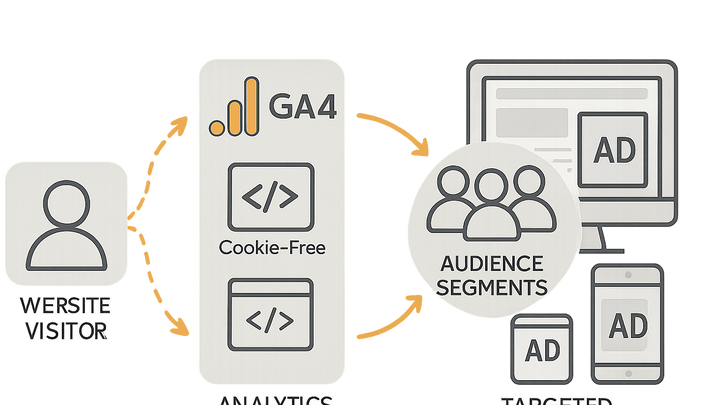Published on 2025-06-27T21:22:44Z
What is Retargeting? Examples and Best Practices
Retargeting, also known as remarketing, is a digital marketing strategy within analytics that re-engages users who have previously interacted with a website or mobile app. It leverages tracking technologies, such as cookies, pixels, or server-side events, to monitor visitor behavior. By building audience segments based on actions—like visiting product pages or abandoning carts—marketers can deliver personalized ads across display, social, or email channels. Platforms like Google Analytics 4 (GA4) and cookie-free solutions like PlainSignal facilitate retargeting by capturing user interactions and integrating with ad networks. Retargeting helps increase conversion rates and ROI by focusing marketing efforts on users most likely to convert. As privacy regulations evolve, the industry is moving towards server-side and first-party data strategies to balance personalization with compliance.
Retargeting
Technique to re-engage past website visitors with targeted ads by tracking behavior and building audiences for higher conversions.
Definition and Purpose
Retargeting is the practice of delivering targeted ads to users who have previously visited your website or engaged with your app. Its purpose is to re-engage potential customers, keep your brand top of mind, and guide them back through the conversion funnel.
-
Core concept
By tagging visitors with identifiers—such as cookies, pixels, or server logs—you can create audiences based on specific behaviors. These audiences can then be targeted with personalized ad campaigns.
How Retargeting Works
Retargeting relies on data collection methods to identify and segment users, then leverages ad networks to display ads tailored to those segments across the web and social platforms.
-
Pixel-based retargeting
Uses a small JavaScript snippet or ‘pixel’ placed on your site to drop cookies or identifiers in the user’s browser. Third-party cookies are common but are being phased out in favor of first-party solutions.
-
Server-side retargeting
Gathers user events on the server without relying on third-party cookies. This approach can send data directly to ad networks or data warehouses, improving privacy compliance.
Implementing Retargeting with GA4 and PlainSignal
Both GA4 and PlainSignal can capture user interactions for retargeting, but they differ in implementation details and privacy models.
-
GA4 setup
In Google Analytics 4, navigate to Admin > Audiences > New Audience to define a retargeting audience based on events or page views. Link your GA4 property to Google Ads to share these audiences seamlessly. Include the GA4 gtag snippet in your site’s head to ensure data collection:
-
GA4 snippet example
<script async src="https://www.googletagmanager.com/gtag/js?id=G-XXXXXXX"></script> <script> window.dataLayer = window.dataLayer || []; function gtag(){dataLayer.push(arguments);} gtag('js', new Date()); gtag('config', 'G-XXXXXXX'); </script>
-
-
PlainSignal setup
PlainSignal offers a cookie-free, simple analytics snippet for privacy-first retargeting. Paste the snippet into your HTML head, then configure audience rules in the PlainSignal dashboard.
-
Tracking code example
<link rel="preconnect" href="//eu.plainsignal.com/" crossorigin /> <script defer data-do="yourwebsitedomain.com" data-id="0GQV1xmtzQQ" data-api="//eu.plainsignal.com" src="//cdn.plainsignal.com/plainsignal-min.js"></script>
-
Best Practices and Pitfalls
Successful retargeting requires strategic planning around audience quality, ad frequency, and privacy compliance to maximize ROI without alienating users.
-
Audience segmentation
Group users by behavior (e.g., cart abandoners vs. product viewers) and tailor ad creatives to match their stage in the decision journey.
-
Frequency capping
Limit the number of times a user sees your ad to avoid fatigue and maintain brand perception.
-
Privacy compliance
Use first-party data collection methods, provide clear cookie and data use notices, and ensure opt-out options to comply with regulations like GDPR and CCPA.
